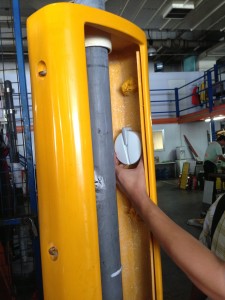by James Lam | Interviewer: James Lam, Rishabh Rastogi, Lee Kyung Min (May) | 24 January 2014
Think about going into a shopping mall blindfolded.
Would you be able to find a 7-Eleven just by smelling and listening?
With the E-Guide project under Prof. David W.L. Cheung of the Department of Computer Science at HKU, Visually Impaired (VI) people can feel more accompanied when they visit public places such as shopping malls.
Apart from the smell and noise, they can now rely on an electronic guide without having to guess what is being sold as they enter a shop.
How E-Guide Came to His Mind
Trained in computer science, Prof. Cheung has a career in data management and e-commerce. However, he recently noticed the rising concerns over the under-privileged in society.
When asked what inspired him to create something that assists the blind, he said, “… not particularly for research purposes… [but] because I feel that there will be good uses… As a researcher or technology developer, the biggest challenge is, if you develop something, are there going to be people using it?”
At the same time, the Hong Kong Federation for the Blinds approached him for help. To allow the VI to direct themselves around such a complex city as Hong Kong, Prof. Cheung set out to work with his team.
Designed to Help
The project includes a low energy Bluetooth transmitter and a receiving device similar to a cell phone. The transmitter gives out signals drawn from the back end system to the receiver. The receiver reads the signal and voices out the message to its user. Since the energy use is little, batteries are enough to keep it running. The back end system can be updated with shop information in different languages.
With this E-Guide, the VI will have more information about their whereabouts in addition to the existing tactile guide paths and Braille maps. With recent developments on an app for iOS devices, together with a specially designed cover on a smartphone, the VI can even use mobile phones as guides.
Although the theory behind the technology used and the device itself are simple, it’s not easy to work out such inventions for the disabled. The project team had to put themselves into the users’ shoes, and to do so they had to work very closely with the NGO for relevant feedback. As a result, the product turned out to be very user friendly, tailor-made for the blind.
Lessons Learned from the VI
The project gave the team a deeper understanding of the visually disabled.
Mr. Patrick K.C. Yee, the project leader, said, “We didn’t consider the sound quality very much, [but] they spent much more time on which speaker was the best to put into the device. They said, ‘We cannot see, so sound quality is very important.’” The VI have especially keen senses — a negligible detail to ordinary people can be of great significance to them.
Potentials for the Future
Prof. Cheung and the E-Guide team didn’t face a lot of financial challenges because of their good intentions for the underprivileged. They received an overwhelming response from organisations such as the MTRC, the Link, Harbour City, 1881 Heritage, Hong Kong Arts Centre, LegCo, the Hospital Authority; and more are to come.
Take a closer look at your surroundings the next time you are at the Tai Wo Hau MTR station, Wong Tai Sin Plaza or the Hong Kong Arts Centre. Prof. Cheung’s team is now working with New World First Bus, Citybus and Ebenezer School to carry out the second phase of testing — to install the devices on buses and at bus stops, so that the VI are provided with information about bus routes.
Besides its uses for the VI, the device has great potential: it can be developed into a guide for ordinary people as well, especially for tourists in museums, shopping malls, and transportation systems. In Prof. Cheung’s words, “This is not Octopus yet, but it has the potential”. They are waiting for this opportunity patiently. They are also looking for partners outside of Hong Kong, hoping that in the near future the device would help the blind around the globe.
Their success has once again proven that technology can make life easier for everybody. Let’s hope that one day, with the help of technology, all physically challenged people can live a convenient life just like ordinary people do in a “barrier-free” city.
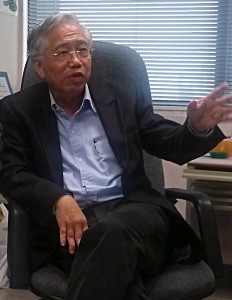 Professor Cheung is also the Director of the Center for E-commerce Infrastructure Development (CECID)
Professor Cheung is also the Director of the Center for E-commerce Infrastructure Development (CECID)
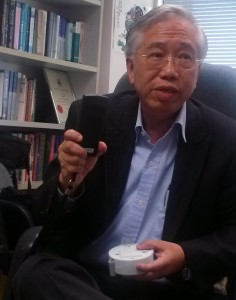 Professor Cheung, showing the receiving device in his right hand and the transmitter in his left.
Professor Cheung, showing the receiving device in his right hand and the transmitter in his left.
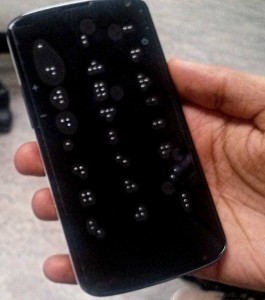 Specially designed braille cover for the blind.
Specially designed braille cover for the blind.
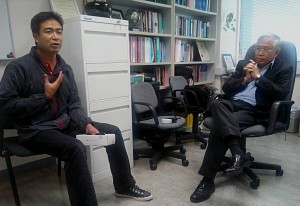 Left: Mr. Patrick K.C. Yee, the project leader.
Left: Mr. Patrick K.C. Yee, the project leader.
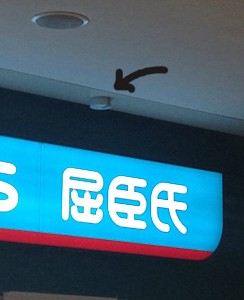 Transmitters fixed at entrances of stores.
Transmitters fixed at entrances of stores.
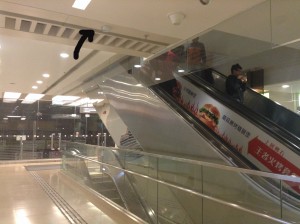 Transmitters placed in shopping malls.
Transmitters placed in shopping malls.


